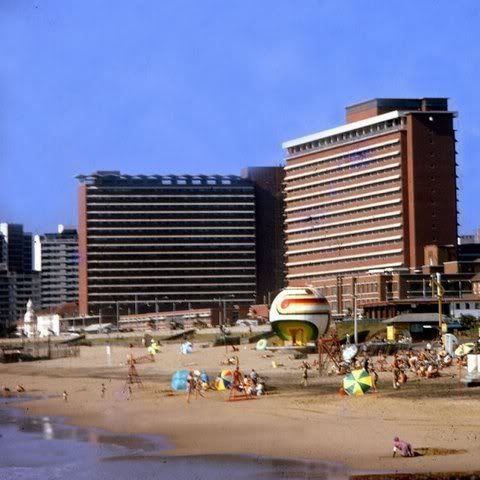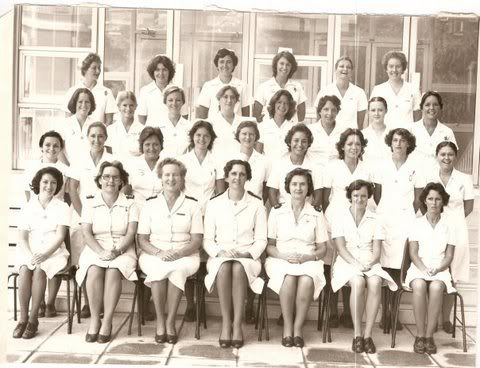The red brick building on the left. The beach was South Beach, and it had lifesavers and shark nets. It was a favourite for surfers. In fact, when I was in High School, when certain boys were absent, the teachers would remark that the surf must be up that day.
Another attraction of Addington Hospital was that it was air conditioned, and that was important because Durban isn't only hot, its very humid at times. The air would be so saturated that it could not absorb sweat so you walked around with sticky wet skin. There was a law that when the temperature reached a certain level with humidity above 80%, schoolchildren had to be sent home.
The red building furthest away that is sideways was the New Nurses Home. The Old Nurses Home was across the road and joined to the Childrens Hospital. As groups of student nurses arrived, they were put in the smaller Old Nurses Home. When they passed Preliminary Training School, they were moved into the New Nurses Home. When Matron came to see us at the end of PTS, we said we didn't want to move; that we liked the Old Nurses Home. So she smiled sweetly and said we had just cooked our own goose; that if we liked it so much, putting new student groups in there was the right thing to do.
Finally, a group photo. I wasn't in this group, but I wore those white uniforms and white cap. The Matron who told us we had cooked our own goose as far as the Nurses Home went is the very tall lady in the middle. Mrs de Goede, as she was then. She divorced and reverted to her maiden name of Smith. She was an excellent and authoritative Matron who knew everything that went on, and who could scare the life out of people.
The qualifed nurses in the front row have cherry red epaulettes on their shoulders. They are known as "Distinguishing Devices" and it was against the law to work as a nurse without them. The cherry red epaulettes were for trained Sisters, and bars were added for extra qualifications. A white bar was for a qualified Sister Tutor, green one for a Midwife, a blue one for a Psychiatric nurse, a yellow one for Community Health and a silver one for Nursing Administration. Before you could do any of those extra qualifications, you had to do your basic Sister's Training first. There were other qualifications that were not represented by a bar on the epaulettes, such as Intensive Care, Operating Theatre Technique, Paediatrics, Occupational Health, Gerontology, Family Planning, Traumacology and others.
Staff nurses did a less academically demanding course and wore white epaulettes as their distinguishing devices. There were two other epaulettes - navy for a psychiatric nurse and green for midwives who had done standalone courses, but they were being phased out in the 70s.
Living in England now, I see the wisdom of that. A good basic training is essential. Here, if you are a qualified nurse for adults, you cannot look after children. Midwives know midwifery, but not much else. And psychiatric nurses seem to be unaware that their patients can be physically sick as well. I had a conversation with one who thought that hypogammaglobulinaemia and anaemia were the same thing, and she was a senior charge nurse. Midwives will have patients with epilepsy, heart disease, kidney disease etc, and not know what to look out for. This sub-specialisation obviously is a handicap because a patient is not merely a gravid uterus or a depressive or schizophrenic, but a person with a body that can and frequently does, have ailments outside of the scope of the standalone qualification.
In South Africa, a general nurse learns enough paediatrics to nurse children properly and enough midwifery to be able to do a fair bit of the basics and to recognise when something is going wrong and to call for competent help. We also had to serve time in the Operating Theatres and Intensive Care Units.
We were in College for part of the year, but we had Clinical Tutors who came to work with us on the wards on a one to one basis. They would observe you doing a procedure and mark you for it, as well as asking questions about it. Once you had passed your Clinical Assessments for a procedure you were allowed to do it unsupervised, but not until then. We were sent to different wards for a month at a time, and the Ward Sister had to write reports on the student's performance, their initiative, record keeping, competence, interaction with patients and staff, teaching ability (yes, I did mean to say teaching ability) and other areas. If your ward reports were poor or if you didn't do well in your Clinical Assessments, you would not be entered for exams. If a student was good practically but did badly in exams, she could be dropped down to the Staff Nurse course. After working for two years as a Staff Nurse, she could apply to be put on a two year Bridging course to work towards becoming a Registered Nurse.
At the end of our training, which was rigorous, Addington nurses could cope with anything they were asked to deal with. There was a confidence borne of knowledge and experience. I have not worked as a nurse for many years, but I still know what to do in a crisis. We were taught to be aware of our surroundings, and it became a subconscious habit. Some years ago, we were in a restaurant. Michelle had a glass of beer. She lit a cigarette, but the lighter was faulty and her hand caught fire. I had already registered that the floor was wooden, so told her to throw the lighter on to it as I knew it would not catch fire like the paper table cloth would. Then I told her to plunge her hand into the beer. That would put out the fire, as beer does not have enough alcohol to make the fire worse, and it was cold which is good for a burn, and it had enough alcohol to be antiseptic. It takes a while to write and a while to read, but in real life it all happened within seconds. And it was because of my Addington training, and done without having to stop and think.
There have been many similar incidents, and I am not an exceptional person. Just a well trained Addington girl.





No comments:
Post a Comment